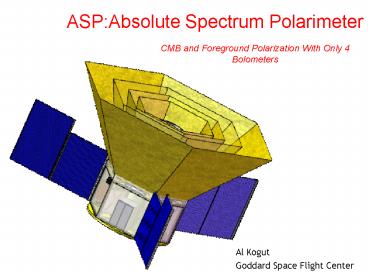ASP:Absolute Spectrum Polarimeter - PowerPoint PPT Presentation
1 / 29
Title:
ASP:Absolute Spectrum Polarimeter
Description:
... Polarization With Only 4 Bolometers. Absolute Spectrum Polarimeter ... 'Harp' single-polarization bolometer 'G String' sets conductance to bath. Thermistor ... – PowerPoint PPT presentation
Number of Views:46
Avg rating:3.0/5.0
Title: ASP:Absolute Spectrum Polarimeter
1
ASPAbsolute Spectrum Polarimeter
CMB and Foreground Polarization With Only 4
Bolometers
Al Kogut Goddard Space Flight Center
2
Absolute Spectrum Polarimeter
Team Members
Explorer-Class mission concept to measure
spectrum and polarization of sky from 30 GHz to 5
THz (1 cm to 60 ?m)
3
CMB Polarization Are You Kidding?
How Do You Measure Signals at Parts-Per-Billion
Level?
Typically think in terms of kilo-pixel detector
arrays with some front-end polarization
modulator.
But there is another solution
4
Photon Noise and Etendu
Photon noise density
Proportional to etendu A?
Sampled Noise
Proportional to ( A? )1/2
Sky Noise (Specific Intensity)
Proportional to ( A? )-1/2
Single-Mode Optics A? ?2 Beam size and
etendu scale with wavelength
Multi-Moded Optics A? N ?2 Beam size and
etendu constant
Number of modes N scales with wavelength
Want Multi-Moded Optics with Really Big
Detectors! Improve Sensitivity by Factor N A? /
?2
5
Instrument Concept
- Polarizing Michelson Interferometer
- Interfere 2 inputs
- Optical Phase Delay
- Measure Fringe Pattern
- Big detectors A? 4 cm2 sr
- Wide Frequency Coverage Fourier Transform
Spectrometer for spectrum 30 GHz -- 5 THz - Multiple Nulls and Modulation
- External Calibrator Nulls Spectrum
- Spin and Phase Delay Modulate Signal
- Sun-synchronous polar orbit (COBE orbit)
Measured Fringes ? Difference Spectrum Between
Orthogonal Polarizations
6
ASP Optics (unfolded)
Define 2? tophat beam on sky
Separate polarizations
Split Beams
Optical Phase Delay ?2z?/c
Re-Combine Beams
Mix Polarizations
Detect Interference Fringes
7
ASP vs Polarization Challenges
4 detectors sense 44,000 modes in 40 spectral
bins for CMB
8
ASP vs Polarization Challenges
4 detectors sense 44,000 modes in 40 spectral
bins for CMB
9
ASP vs Polarization Challenges
4 detectors sense 44,000 modes in 40 spectral
bins for CMB
10
ASP Interferograms
Forward
Reverse
Near stop to null
Far stop to null
Null to near stop
Null to far stop
Same information 4x / stroke with different
time/space symmetries Transform Real partSignal
noise, Imaginary partNoise only
11
ASP Spin Modulation
Time-Ordered Data for Polarized CMB
4 RPM spin provides amplitude modulation of
entire interferogram
Noiseless Sim Sinusoidal Systematics
Powerful tool against spin-synchronous systematics
12
ASP Schematic
Beam to Sky
Calibrator
2.7K ADR
Calibrator Cntwght Motor
Field Mirror
2.7 K
Collimator A
ASP Instrument
Collimator B
Polarizer Grids
Dihedral Assembly
MTM
Sunshades
Collimator C
Detectors
Collimator D
Primary Mirror B
Primary Mirror A
Cryocooler
Thermal Break
Cryocooler Compressor
Cryocooler Elec Box
Cryocooler Radiator Panels
Instrument PWAs
300 K
S/C Bus
13
ASP Instrument and Observatory
Spin 4 RPM
Instrument Box (2.7 K)
Blackbody Calibator
Primary Mirror A
Thermal Break
Dihedral Mirrors
To Sun
4 Detectors (100 mK)
Radiator Panels
Polarizing Grids
Solar Panels
To Earth
14
Sensitivity and Frequency Coverage
- 30 GHz to 5 THz
- (1 cm to 60 ?m)
- ?? 15 GHz (R 300)
- Noise 2 Jy/sr in each bin
- ( 2 x 10-26 W m-2 Hz-1 sr-1 )
- CMB Parameters
- ? lt 10-6
- y lt 10-7
- r ltlt 0.01
nK Sensitivity for CMB B-Mode Spatial Structure
Using Only 4 Bolometers!
15
ASP Samples Cosmic History
Inflation and the Oldest Information in the
Universe
Chemical Potential ? Dark matter
annihilation/decay
Compton y distortion vs E-mode pol Reionization
and First Stars
Far-IR Background Matter at z3
Galactic Line Emission Energy Balance of
ISM Chemical Separation of ISM
16
B-Mode Polarization
Sensitivity limit set by foregrounds, not noise
Tensor/scalar ratio r ltlt 0.01
r0.1
r0.01
17
Secondary Science Reionization
Neutral IGM
Reionization is complex and not well
understood Pop III? Pop II? Feedback?
First Stars Pop III? Pop II?
- Reionization and Compton Scattering
- Polarization Optical depth ? ? n(z)
- Spectrum Compton distortion y ? nkTe
- Combine to get Te (ionizing spectra)
Ionized IGM
Observer
"Guaranteed Science" -- Signals must exist
18
Secondary Science Far-IR Background
Thermal Dust Emission from z 3 Monopole Galaxy
Evolution Dipole Motion Anisotropy Matter power
spectrum
ASP noise is down here!
19
Secondary Science Foregrounds
- Continuum Emission
- Synchrotron, Dust
- Line Emission
- CO, C, N, OIII,
- Diffuse ISM
- Temperature, Density
- Energy Balance
- Chemical Separation
300 Spectral Maps Stokes I, Q, U ?? 15 GHz
Extremely Rich Data Set!
20
Now How Much Would You Pay?
You get your inflation, your dark matter, your
reionization, your infrared background, AND your
Galactic dust/ISM
Operators are standing by!
21
(No Transcript)
22
(No Transcript)
23
ASP Blackbody Calibrator
Al Core
Absorber "skin"
Thermometer
- Power reflection R lt 10-6
- Based on Successful ARCADE Calibrator
- Null spectrum for interferometer
- Continuous calibration for detectors
24
Detector Summary
"Harp" single-polarization bolometer
Silicon Frame
"G String" sets conductance to bath
Thermistor
"Harp String" Polarizing Absorber Doped silicon
for impedance match 3 ?m x 1.5 ? m x 13000 ?m 30
?m pitch
Thermalizer Bar
25
ASP "Wide" Channel Sensitivity
Channel Sensitivity After Apodization (CMB
channels only)
26
Spacecraft
27
Cryogenic Design
2.7 K
ADR
0.1 K
ADR
2.7 K
Sun Shields
Instrument Isothermal with CMB (2.725 K)
Cryo-Cooler
5 K
Thermal Break
300 K
Spacecraft
28
Spectral Distortions
ASP limits Compton Distortion y lt 10-7 Chemical
Potential ? lt 10-6
Compton Scattering
Compton ?T ? ? nkTe
Log I
Chemical Potential
Redshift z 106
Log ?
29
ASP and Dark Matter
Dark matter annihilation injects energy into
early universe
Annihilation ?? ? qq or ?? injects energy ?E
m? Annihilation rate n2 z6 larger at early
times
Observable limit ? lt 10-6 yields m? gt 10 MeV
McDonald, Scherrer, Walker 2000, PRD, 63, 023001































